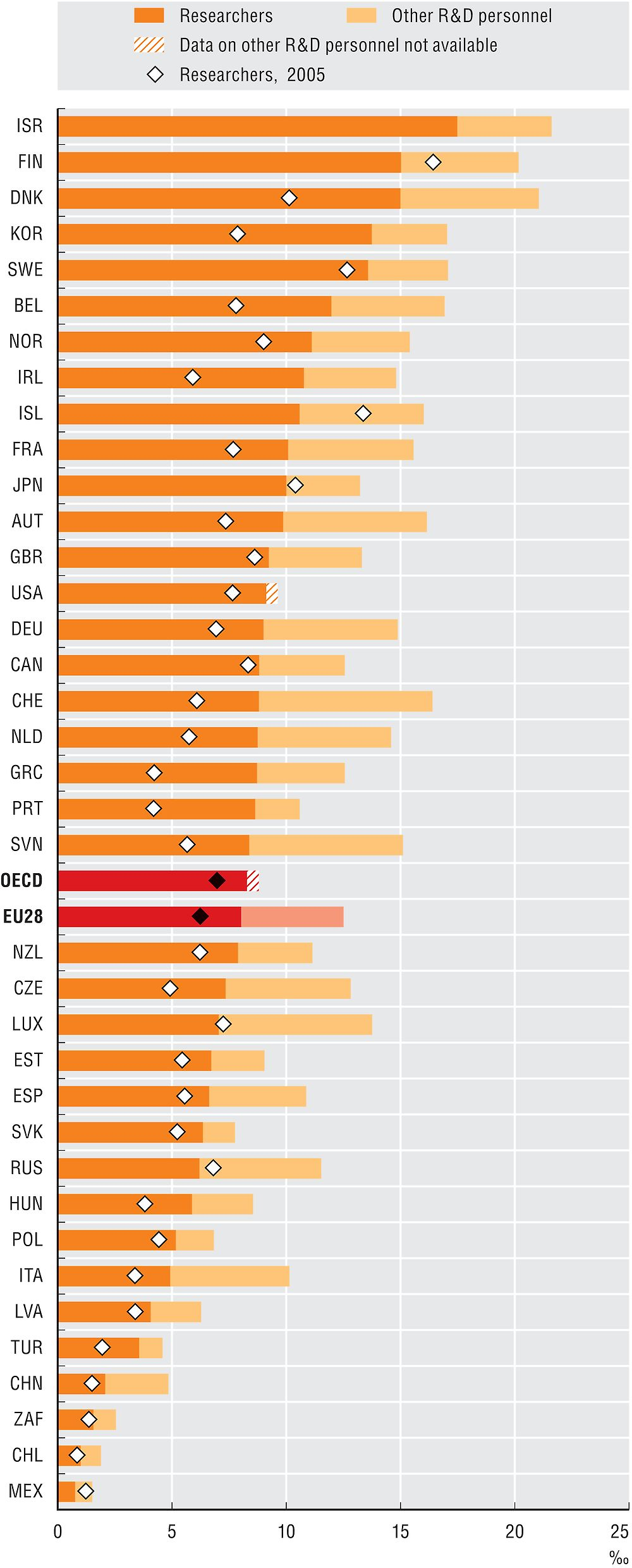4. Researchers

Source: OECD, Main Science and Technology Indicators Database, http://oe.cd/msti, July 2017. StatLink contains more data. See chapter notes.
Latvia achieves gender parity in the number of researchers, while in Sweden women perform more research in companies than men.
Researchers and other R&D personnel constitute a vital input to R&D performance. Measured on a full-time equivalent (FTE) basis, over 2% of persons employed in Denmark, Finland, and Israel work in R&D – almost double the average of other countries (1.1%). Norway and Ireland rank highly even though their R&D spending is below the OECD average. The number and share of researchers has risen between 2005 and 2015 in most countries, though the share of researchers in total R&D personnel varies widely: from over 80% in Israel, Korea, the Slovak Republic, Sweden, and Portugal to 49% in Italy and 43% in China.
The business enterprise and higher education sectors are the main employers of researchers. Business represents the greatest share - over 70% of researchers in Israel, Japan, Korea, and the United States. The share of researchers working in the business sector has increased markedly between 2005 and 2015 in Hungary, Poland, and Turkey, but fallen in Greece, Luxembourg, Mexico, and South Africa.
Over 40% of researchers in Estonia, Latvia, Portugal, the Slovak Republic, and South Africa are women, while fewer than 25% are women in Austria, the Czech Republic, and Germany. Higher education institutions often employ the greatest share of women researchers. In Luxembourg, the creation of the country’s first and only public research university in 2003 helped to produce a 10 percentage point increase in women researchers up to 2015.
Definitions
Research and development personnel include all persons employed directly in R&D activities, and comprises technicians and support staff as well as researchers.
Researchers are defined as professionals engaged in the conception or creation of new knowledge. They conduct research and improve or develop concepts, theories, models, techniques, instrumentation, software, or operational methods and are typically directly involved in the management of R&D projects.
R&D personnel are represented in full-time equivalent units defined as the ratio of working hours actually spent on R&D during a specific reference period (usually a calendar year) divided by the total number of hours conventionally worked in the same period by an individual or a group. A person working half-time on R&D is thus considered 0.5 of a person-year in R&D FTEs. This yields a more accurate measure of the volume of human resources devoted to R&D in a country than headcounts or jobs. For international comparisons, R&D personnel figures are normalised by total employment, as reported in OECD National Accounts statistics.

Source: OECD, Research and Development Statistics Database, http://oe.cd/rds, June 2017. StatLink contains more data. See chapter notes.

Source: OECD, Research and Development Statistics Database, http://oe.cd/rds, June 2017. StatLink contains more data. See chapter notes.
Gathering detailed information (e.g. gender, age-band, qualifications, geographic origin, etc.) on people performing R&D can prove challenging. The Frascati Manual 2015 (http://oe.cd/frascati) prescribes breakdowns for R&D employees, because R&D performers are more likely to be in a position to provide such details for people they employ directly. However, some countries also include external persons, such as on-site consultants or unpaid volunteers, in their R&D personnel figures. In recent years, a number of countries have extended coverage of certain groups – such as funded PhD students or all permanent university academic staff – as researchers. Estimation methods also vary; for example, methods used to calculate FTEs may vary not only from country to country but also across sectors within countries, owing to differences in the data sources used to estimate R&D in each sector. Estimating FTEs is particularly challenging in higher education, as many researchers typically engage in other activities, such as teaching or administrative tasks – some at the boundary of R&D. Such variations between countries impact international comparability.
